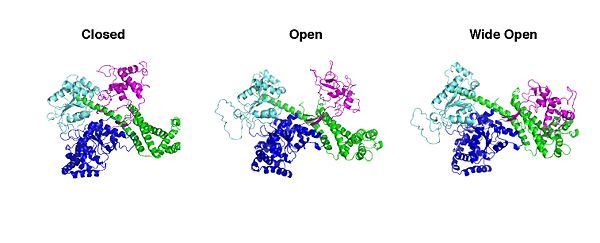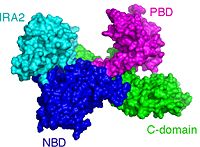PBD moves
Protein secretion is essential for all organisms. Bacteria have evolved a plethora of secretion systems to handle the various proteins that need to be exported from the cytoplasm [1]. Most of these proteins bear an amino terminal extension termed signal peptide and they are called preproteins. The Sec secretion system is uniquitus and essential for cell viability. In bacteria, the Sec system consists of the membrane embedded heterotrimeric complex SecYEG that forms the channel through which preproteins are threaded and the cytoplasmic nanomotor SecA. SecA spends chemical energy to produce mechanical work that somehow pushes and threads preproteins through SecYEG.
SecA constists of 4 domains; the (NDB); the (PBD); the (IRA2) and the (C-domain). SecAs from different organisms have been visualized [2]. The most prominent difference between the protomers of visualized SecAs is an 80o rotational and translational movement of the around its that connects it with NBD.
PBD is the site where signal peptides of preproteins dock [3] and from there they control ATP hydrolysis at the NBD-IRA2 interface [4].
So far no functional role has been unequivocally atributed to this rotational motion. It has been suggested that PBD rotates to allow the opening of a clamp-like structure. This clamp has been shown to be the site where preprotein chains are located during their translocation [5][6].
SecA has been visualized in a Wide Open [7]; an Open [8] and a Closed conformation [9], according to the position of the PBD.
There are few working hypotheses about the importance of this PBD swiveling motion. PBD motion could be the ATP-driven mechanical event that pushes preproteins through the SecYEG pore or it could prevent their backsliding. The implementation of single molecule techniques (e.g. single molecule FRET analysis) could provide us with high resolution information about the functional role of this extremelly dynamic domain.

SecA in three conformational states


